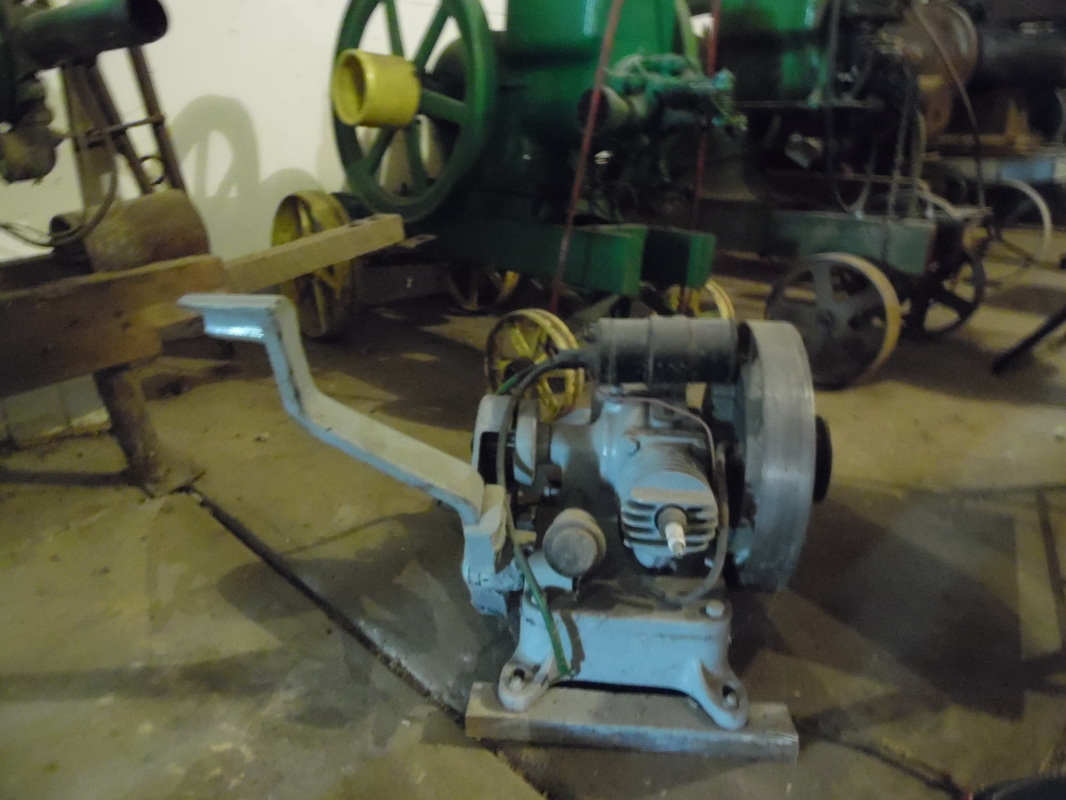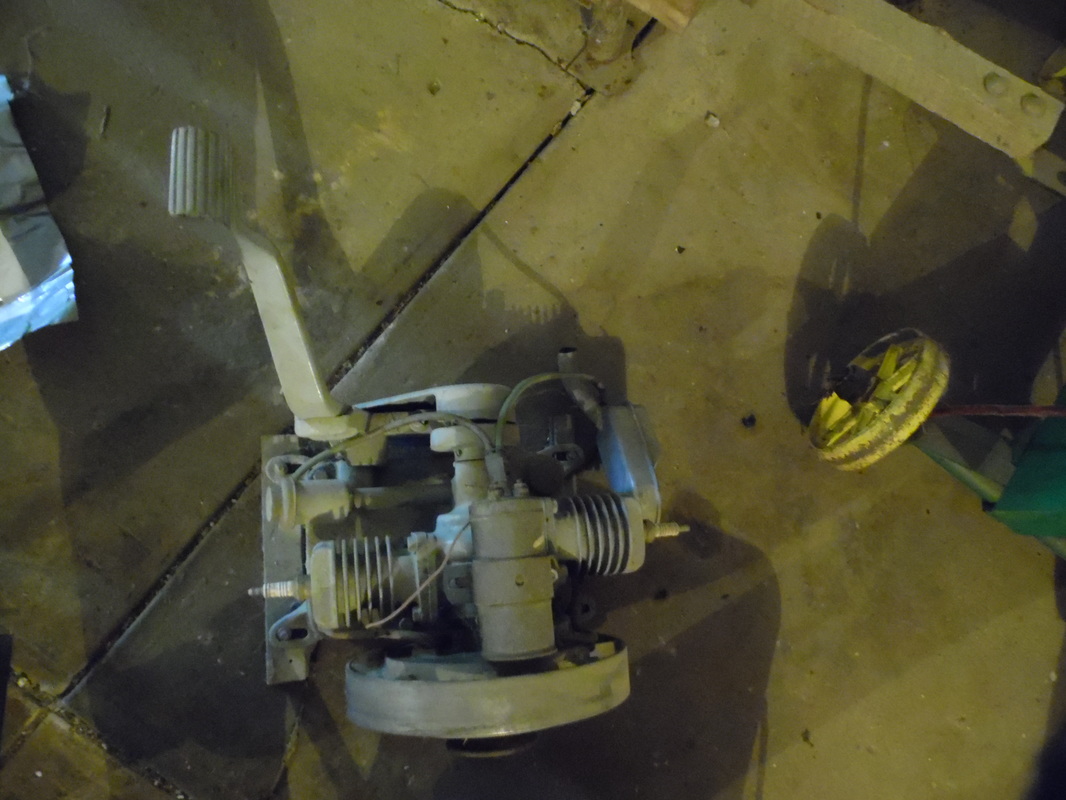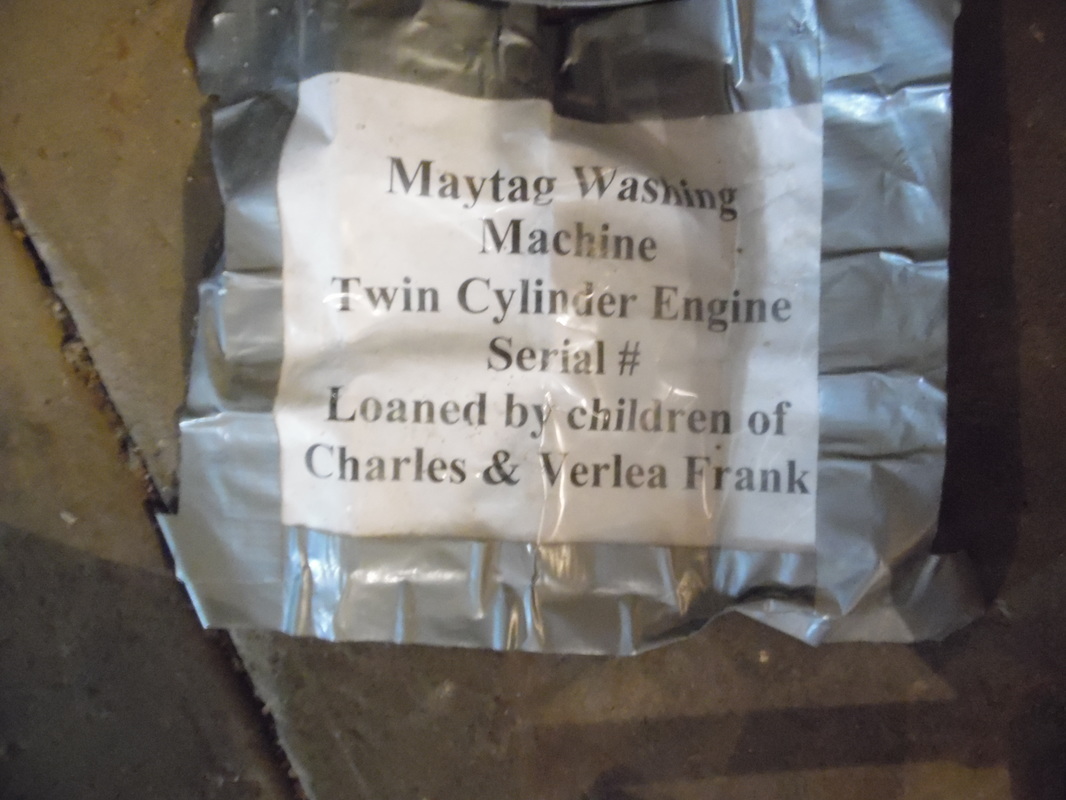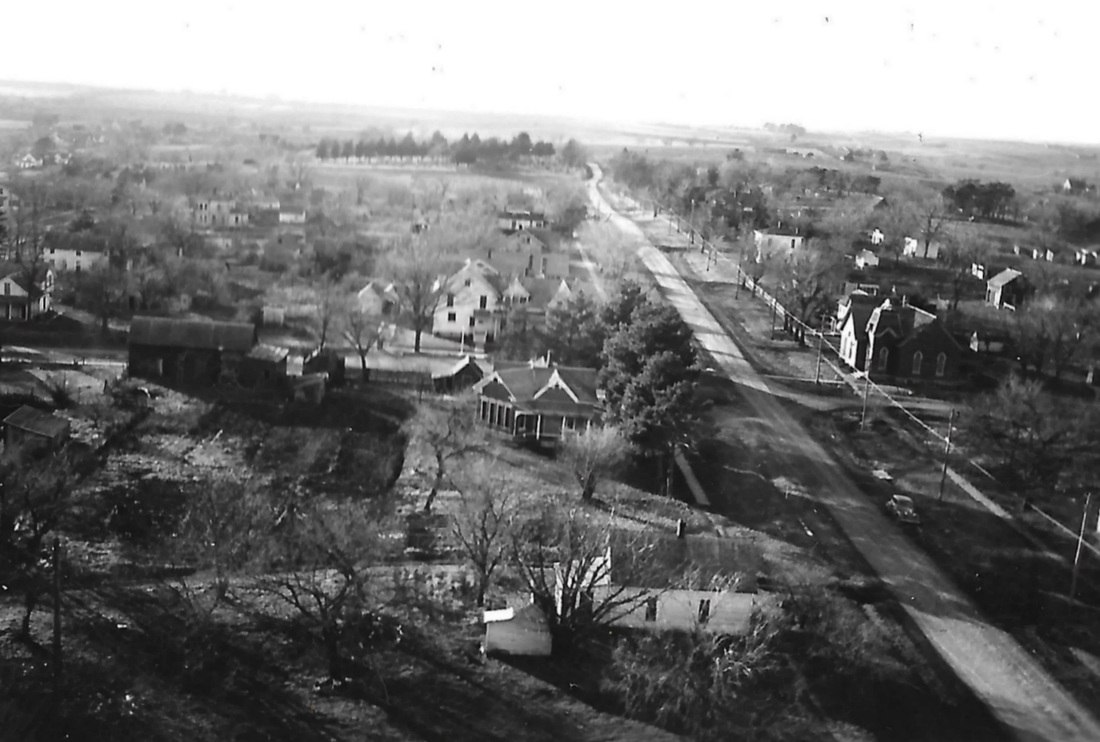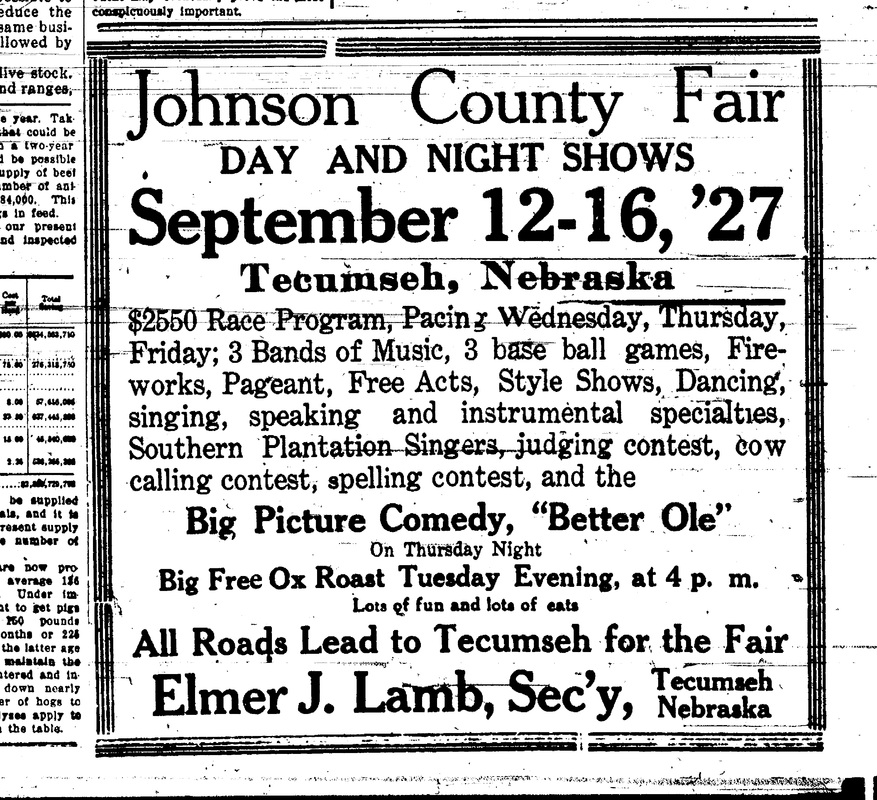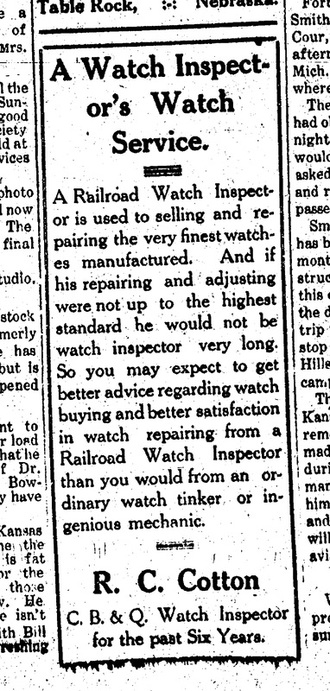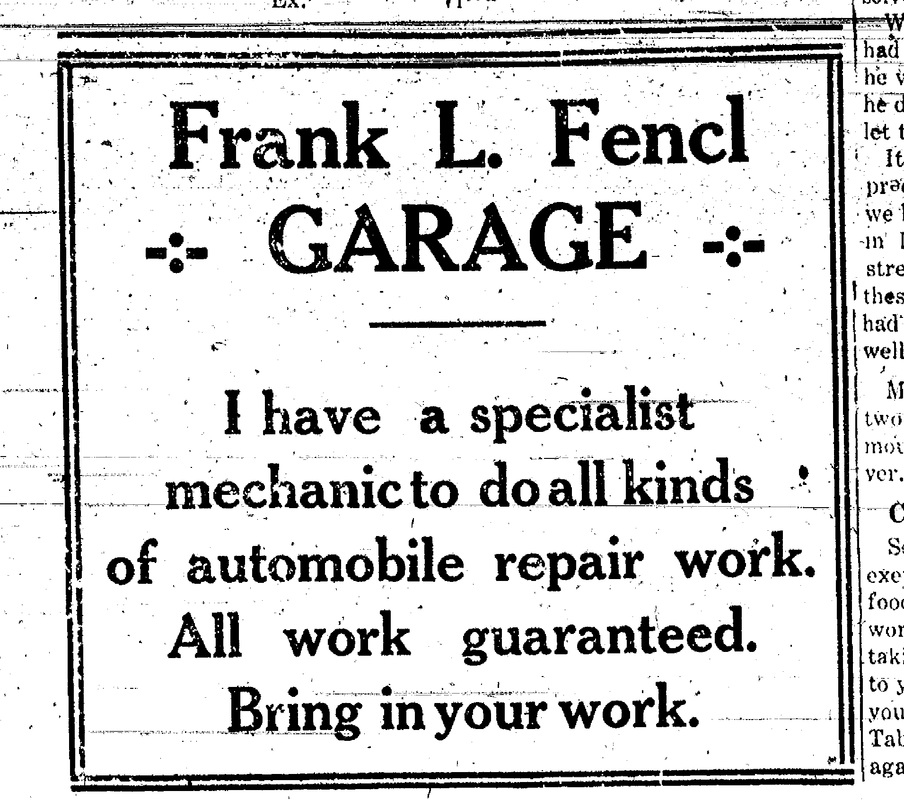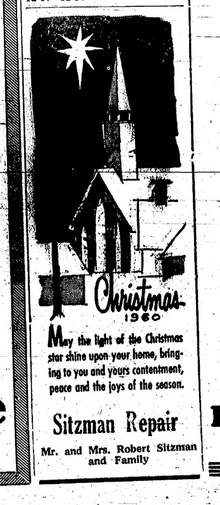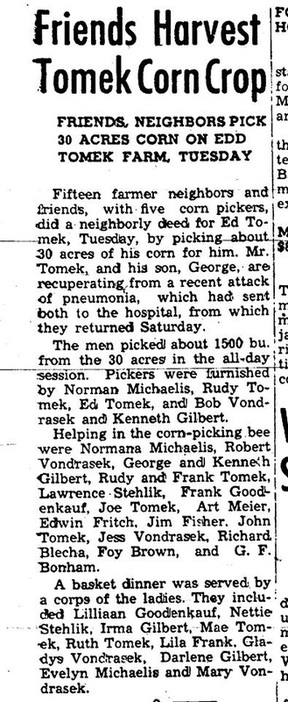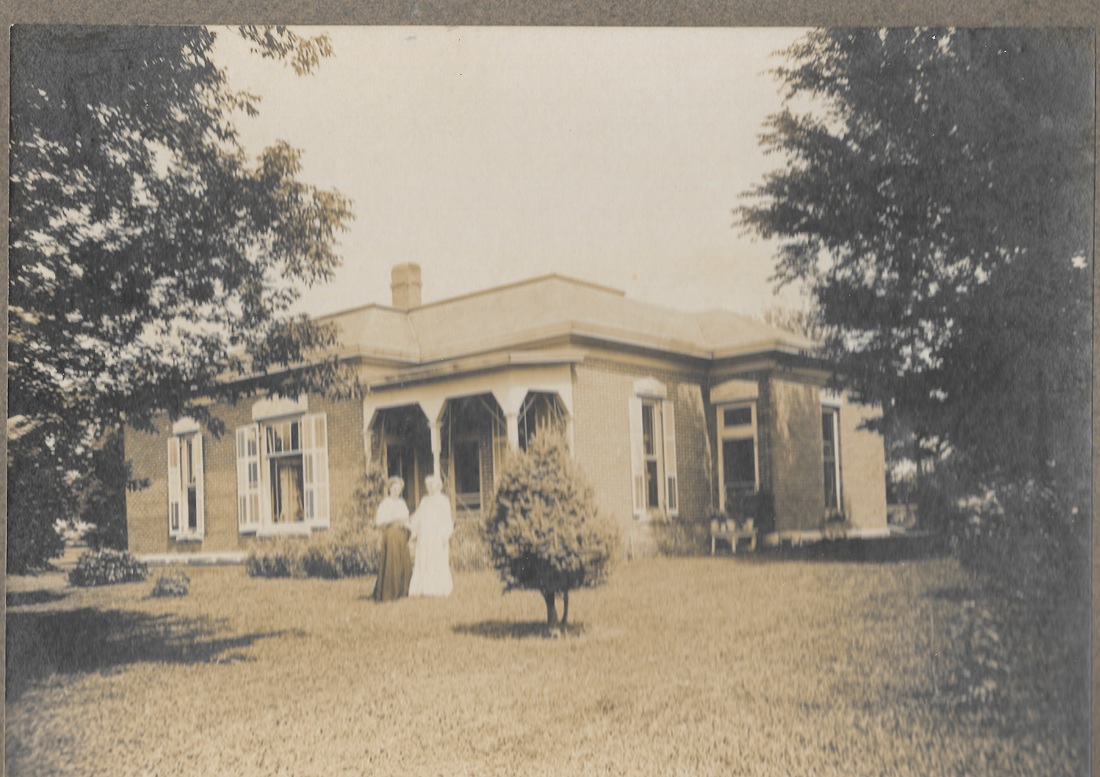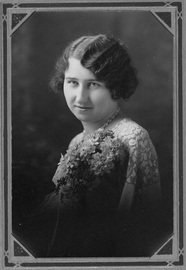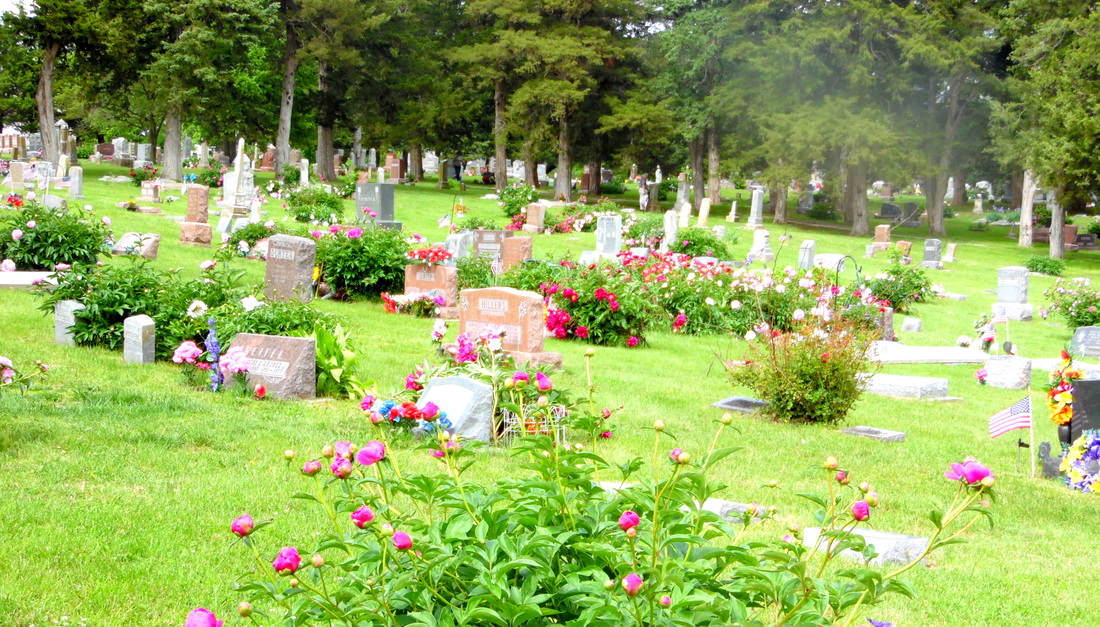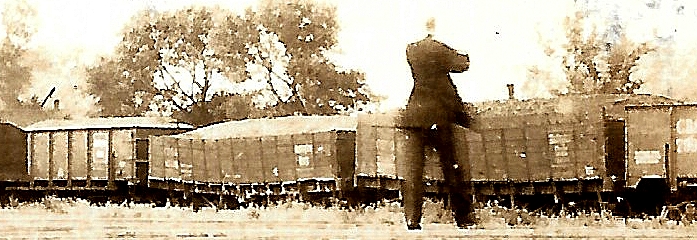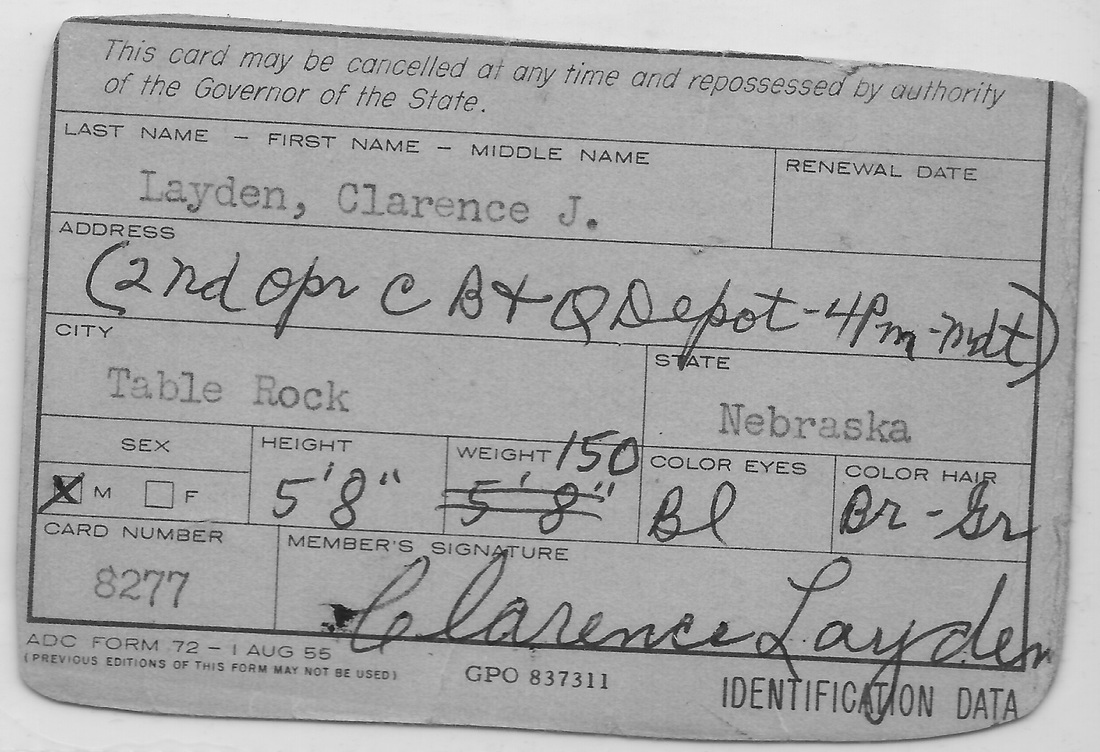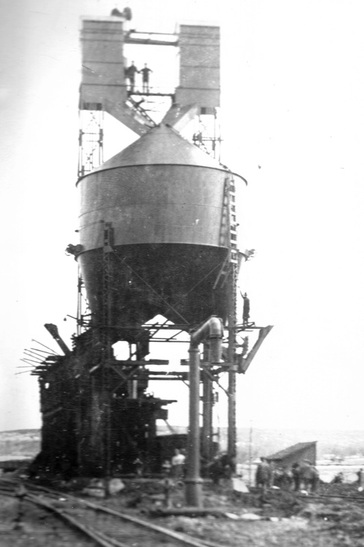STORIES FROM LARRY LAYDEN
|
Larry Layden is a Table Rock graduate (Class of 1961), a Marine Corps veteran, a retired rail road worker, a lover of history, and -- best of all -- a story teller.
SCROLL DOWN FOR LARRY'S STORIES |
Index
|
THE OLD FIRE STATION IS built OVER
AN OLD "FIRE HOLE"
That's what they called them in Argus articles in the 1920s & 30s. Basements left exposed when buildings burned down. The most well known ones were on the south side of the Square, left for decades after the 1920 fire that leveled the buildings between Sochor Electric and the Hotel Block. Larry Layden remembers another of them that persisted in his childhood.
The area where the fire hall now sits was a vacant lot where two buildings used to sit. There were two large holes that comprised the basements surrounded by natural stone basement walls. That area was separated from the sidewalk by a wood fence extending south from the creamery. The fence was supposed to protect the public from the hazardous hole and crumbling foundations but us kids thought it indicated a playground was near. I was told the buildings were destroyed by a fire so it is fitting that they were replaced by a fire house. |
WASH DAY - KICK STARTING THE MAYTAG
|
When I posted photo 1030 on Facebook, a picture of Emma Tomek by her son Edward, from the mid 1950s, Larry gave us a memory
I remember the washing machines that were located in the house or on the porch that were powered by an air cooled, gas fueled. 3/4 horse Maytag engine connected to a flexible metal pipe that directed the exhaust out side. |
working at smitty's grocery store, carrying smoked baloney on a broomstick
|
It, like Table Rock, has a history. In the early 50's the retail store on the west side of the theaterwas Smitty's Grocery.
My sister, Beverly (Layden) Wilcox, worked behind the cash register and she got me my first job at age 12 or so. I worked very Saturday until noon for 25 cents an hour. I cleaned the meat saw, sausage/baloney maker and a huge cast iron kettle used to cook the baloney. I also carried the baloney out to the smokehouse, kept the fire burning and carried the smoked baloney back in on broomsticks about three feet long. Did all that for one dollar and I was thrilled, had a real job! Wonder what happened to that gas-fired kettle. It was about the same size as the "bean pot" that is in the museum. |
WONDERING ABOUT THAT OLD WAGON TRAIL
I wonder where the Wagon Trail that ran northeast to southwest was located.
I've always been intrigued by a set of wagon ruts I ran across in the early 50's. They ran north and south up the bluff on the EAST side of Goat Hill. That area has an outcropping of shale and the ruts are/were visible along the shale and in the woods at the top of the hill. They had been there a number of years because there were trees growing between the wheel tracks.
About 4 miles north there was a wagon road running along side the Vrtiska homestead in the draw about a quarter of a mile east of the county road where the Lloyd Vrtiska house sets now. That road was in use before the county roads were laid out.
Don't know if those wagon trails were connected.
I've always been intrigued by a set of wagon ruts I ran across in the early 50's. They ran north and south up the bluff on the EAST side of Goat Hill. That area has an outcropping of shale and the ruts are/were visible along the shale and in the woods at the top of the hill. They had been there a number of years because there were trees growing between the wheel tracks.
About 4 miles north there was a wagon road running along side the Vrtiska homestead in the draw about a quarter of a mile east of the county road where the Lloyd Vrtiska house sets now. That road was in use before the county roads were laid out.
Don't know if those wagon trails were connected.
a dog leg in the road
In 1941, Arvid Blecha, then a young man, climbed the water tower. From there he took pictures looking off in all directions. In this one, you see Table Rock looking west. In the center distance you see the cemetery, with its beautiful cedar trees. Larry immediately noted that there was a dog leg in the road. There was no immediate answer. Keeping reading for the answer!
about the dog legFrom Larry: I found out why the road going by the cemetery dog legs north at the northeast corner. Lloyd Vrtiska, a part time surveyor, told me the county surveyor told him that the road is crooked because of a survey error. Table Rock was laid out by two surveyors. One started north of town and the other started south of town. When they met up at the street that goes east and west between the north side of the cemetery and the Methodist Church they found the lots north of the street were 168 feet long. They were suppose to be 160 feet long. They couldn't correct the cemetery street because the cemetery had already planted trees along the north side, so they hugged the trees and left the street as is. Lloyd says he thinks the Civil war statue sits where the north boundary should be and for a long time (maybe even now) there were no lots sold or burials made along the north edge of the cemetery on the land reserved for Table Rocks' angels. JOHNSON, NEBRASKA Another survey snafu involved Johnson, Nebraska. Johnson was intended to be located in Johnson County but when the State checked the placement of the county line they found the surveyor made a mistake and placed the line west of the village of Johnson, removing Johnson from Johnson County. The State sent another surveyor down and told him to relocate the county line one mile east. That surveyor moved the line : one more mile west. The State was receiving a lot of ridicule by this time so they said enough is enough and ended their fixes. Johnson is not in Johnson County and the county line road jogs around the town. |
about arvid blechaArvid's high school graduation picture.
Bill Vondrasek in Johnson, a photo taken by Eward Tomek while on a booster trip to Johnson circa 1955.
Below, the 1927 Johnson County Fair -- taking place west of Johnson. |
how railroads set the time
|
This 1912 advertisement by R. C. Cotton led to Larry's recollections about the accuracy of railroad time.
|
Regarding railroad watch accuracy : they had to be accurate to within 2 or 3 seconds a day. The watches were compared to a "Standard Clock" which was located in the depot at the larger stations. The locations of these "standard" clocks were shown in the timetable by the letter "K" for clock. The "standard" clocks operated on direct current supplied by large dry cell batteries. The standard clocks were synchronized. Here's how: Each day, at 12 noon Eastern standard time, the U. S. Naval Observatory at Washington, D. C., supplied a time signal with a "click" for the exact time of 12 noon. To access that signal, the telegraph operator used a a telegraph-like key to hook the "standard" clock up to the telegraph line. To alert the operator that the synchronizing signal was coming, the word "time" was transmitted a number of times. The last time it would be sent slowly . At that point, the operator would connect the clock to the telegraph line. With the time click that was transmitted at exactly 12 noon, the second hand of the "standard" clock would move and be set to Naval Observatory time. There was silence throughout the country on every railroad while the clock was being set. KFAB, radio would also transmit this time signal. I remember getting many phone calls from the public wanting to know the correct time. I would tell them "the time is 2:38 right..............now" or whatever the time would be. I'll bet a lot of people remember calling the depot for the time. |
glenn freeman's auto repair shop on the south side of the hotel & John Kolacny's blacksmith shopDo you remember Glenn Freeman's? Dad took his car there when I was in high school. He was a good mechanic and was an expert on front end alignment. His son Bob Freeman worked with him. I'm guessing he closed in the mid to late sixties. Might have died about that time.
I also remember John Kolacny. He had a blacksmith shop on the southeast corner of Knapp grocery. Dad used to take plow shares there to have them sharpened. They did not grind them sharp, they heated them up and pounced them sharp with a hammer. I don't think the shop was there very long and I'm not real sure who the blacksmith was. I enjoyed the Facebook post about the husking bee. That is the first time I've seen the name Foy Brown but I think I've heard it before. Was he Donna Brown's father? I remember her mother but only vaguely remember her father.
Donna's mother was the "drayman" for the railroad. She took the mail from the train to the post office and packages that came in on railway express and L.C.L. ( less car load) freight. I used to pay draymen from office funds. I don't remember if they had a fixed salary or worked on commission. Donna might remember how it worked. Her mom was a hard worker and friendly. Editor's Note: Foy Brown -- I THINK that Foy was Donna's father; he was a World War I veteran. Donna's mom was Bea Brown, who I have good memories of. Both are in the Table Rock Cemetery. Donna will hopefully confirm or deny. DONNA BROWN'S parents. her MOTHER WAS DRAYMAN FOR THE RAILROAD |
some other repair shops |
Oops! don't ask, don't tell.
Here's a "Believe It Or Not" story
At Carling Tower where I worked I overheard two old head conductors talking and one said something about checking something on the last trip and it was completely out of sight.
I asked him what he meant.
He told me this story.
He was working a freight train on the Lincoln - Omaha line when the train lost its air in the braking system and came to an emergency stop. This conductor and his brakemen. started walking alongside the train and found that the train had come apart causing the air hose to break it's connection. They coupled the train back together, pumped up the air, released the brakes and went on there way.
When he arrived at Lincoln he looked at the list of his train and found where the break occurred.
He found the two cars that he coupled together and found that there should have been an empty flat car between the two car he coupled together. He figured the list was wrong because he did not see a flat car near the train.
The next time he went by the site where the train came apart he looked along the track for any evidence of a flatcar. Lo and behold he noticed just a bit of the car showing through the trees and weeds at the bottom of a rocky ledge.
He figured he would be in big trouble for not reporting the missing car so he decided to take a chance on no one seeing the car.
Every year the trees grew a little thicker and the weeds a little thicker until at last he could no longer see any part of the missing car and finally felt safe,thinking it could no longer be detected.
Flat cars are pretty light when they are empty and occasionally derail on a curve and cars are sometimes get lost in a yard or siding track. Usually they are found, but not this car. Of course it was not really lost!
This happened on a track by Table Rock on the old Wymore line but that is another story.
At Carling Tower where I worked I overheard two old head conductors talking and one said something about checking something on the last trip and it was completely out of sight.
I asked him what he meant.
He told me this story.
He was working a freight train on the Lincoln - Omaha line when the train lost its air in the braking system and came to an emergency stop. This conductor and his brakemen. started walking alongside the train and found that the train had come apart causing the air hose to break it's connection. They coupled the train back together, pumped up the air, released the brakes and went on there way.
When he arrived at Lincoln he looked at the list of his train and found where the break occurred.
He found the two cars that he coupled together and found that there should have been an empty flat car between the two car he coupled together. He figured the list was wrong because he did not see a flat car near the train.
The next time he went by the site where the train came apart he looked along the track for any evidence of a flatcar. Lo and behold he noticed just a bit of the car showing through the trees and weeds at the bottom of a rocky ledge.
He figured he would be in big trouble for not reporting the missing car so he decided to take a chance on no one seeing the car.
Every year the trees grew a little thicker and the weeds a little thicker until at last he could no longer see any part of the missing car and finally felt safe,thinking it could no longer be detected.
Flat cars are pretty light when they are empty and occasionally derail on a curve and cars are sometimes get lost in a yard or siding track. Usually they are found, but not this car. Of course it was not really lost!
This happened on a track by Table Rock on the old Wymore line but that is another story.
ALL ABOARD FOR THE WORLD’S FAIR!
This story take place at Ravenna, Nebraska, a small to medium-sized town 125 miles west of Lincoln, Nebraska.
It was 1962. I was 18 in 1962 and had been working 4 months doing summer relief at various depots. There was a cheese factory there which used a lot of locally-produced milk. The cream was shipped to a creamery in Minnesota via Railway Express. The daytime agent received a substantial commission for shipping all this cream, which was not shared with the other station employees. But that is another story.
So the first trick operator took the order. The second trick operator (4 pm – Midnight) billed out all the cream and the third trick operator (Midnight – 8 a.m.) had to load it on the train. That’s where I came in. My work started at Midnight and it included loading the cream on the train. I had to load five-gallon cream cans on three-foot high carts that had three foot iron wheels and a long wagon tongue to pull them with. There were usually four or five of those carts of cream and mail and other express packages. Each cart had to be spotted at the correct brick on the platform in order to line up with the doors of the train when it stopped. The engineer would stop the train at a precise spot every night so if everything was lined up the loading would go smoothly. If the carts were not lined up right, then the baggage men in the trains would have to work harder to load the cans and baggage. And they did not like to work hard! One night, I had the carts coupled together and ready to leave the freight room prior to the arrival of the west-bound passenger train. I opened the door to be greeted by almost the entire town of Ravenna. It so happened that the high school band had been selected to play at the World's Fair at Seattle and were boarding the train that night. The town had come down to the station to see them off. There was a pep band playing and everyone was cheering on the students who were leaving. The train pulled in and I had not been able to spot the loaded carts. I tried to get people to move out of the way but no one could hear me. I pulled the carts along the platform and could hear the agonizing cries of those whose toes I had ran over. But the mail and the cream had to get through! Of course I failed to spot the carts correctly, causing many unkind words being said by the baggage men. The conductor showed up and told me I was delaying his train. He helped me re-spot the carts and we finally loaded everything onto the train. Then, the conductor came up to me and said, “Kid, there are people inside wanting to by tickets. Hurry up and take care of them. You are delaying my train! I went inside and found a dozen or more people who at the last moment wanted tickets to Seattle. I had no idea of how to issue a ticket to Seattle. ‘ The conductor was becoming more irate by the minute and told me he was not holding the train any longer. He stomped out of the room fuming, calling me a number of unkind things. ‘ I told everyone waiting to run and get on the train through any door they could find and that nice man who just left would sell them a ticket to Alliance. They could buy a ticket to Seattle at Alliance. They wanted to know about their luggage. I told them to throw it on the train and the man in the blue suit would check it for them. Then a horde of people made a mad dash out of the depot and stormed the train. Within a moments time the platform was clear and the train pulled out. Figured I'd be in trouble the next day but never heard a word about it. I think the railroad was happy to have the ticket revenue and Ravenna was beyond the reach of the ticket agent at Alliance. I think that conductor learned not to mess with that young kid at the depot in Ravenna. |
Cream used to be big in Table Rock. Merchants often advertised to buy it and, as you can see from this May 1913 ad, there must have been some competition.
What does one do with cream? In Table Rock, we made ice cream sometimes, as in ice cream social. here is a July 1907 story about a fundraiser for the band that raised $40. The band was grateful and said to "the ladies," when wanted, "the band is yours!"
We can't mention cream with mentioning the Falls City Creamery. The Pioneer Museum has been located within its walls since 1966! Here it is with Edwin Freeman, Jay Hinton, and Cloyd Freeman.
|
marion bonham
September 7, 2015
Marion Bonham was a Navy Lt. in WW II. He landed and recovered troops on D day at Normandy.
He was the leader of the Methodist Church Junior Choir. There was a reunion in 1982. Larry has some memories to share.
That choir reunion was quite an occasion. The choir was quite famous throughout southeast Nebtaska. We appeared on channel 10 TV back when TV was just getting started. I still have my choir robe. I remember always standing by Donna Brown McCain because we were the same height. I'm sure all the members would enjoy seeing that picture again.
The leader, Marion Bonham, is in the hearts of a lot of people. He was nearly deaf when he led us in song for the last time in 1982. We all had tears in our eyes.
He was the leader of the Methodist Church Junior Choir. There was a reunion in 1982. Larry has some memories to share.
That choir reunion was quite an occasion. The choir was quite famous throughout southeast Nebtaska. We appeared on channel 10 TV back when TV was just getting started. I still have my choir robe. I remember always standing by Donna Brown McCain because we were the same height. I'm sure all the members would enjoy seeing that picture again.
The leader, Marion Bonham, is in the hearts of a lot of people. He was nearly deaf when he led us in song for the last time in 1982. We all had tears in our eyes.
|
The 1982 reunited choir led by Marion Bonham. So it can be found with a Google search, here are the names: Marion Bonham: Alan Gilbert, Larry Gilbert, Don Mertes, Gary Gritch, Don Bedea, Judy Aylor, Gary Bedea, Eugene Steiner, Ivan Vrtiska, Nancy Johnson Loos, Glenda Alderman Blecha, Charlene Parker Thompson, Donna Brown McMann, Mary Jane Bacon, Carolyn Jasa Hogue, Darlene Kolacny Warnick, Christine Olsen Hansen, Lois Layden Gager, Cynthia Meier Weddle, Marilyn Wenzbauer Tomek, Kathy Deubelbeiss Jurgens, Don Wright, Larry Layden, Karen Wenzbauer Gilbert, Joyce Wopata Newton June Gilbert Hess, Marilyn Wright McClanahan, Carolyn Uhri Rottman, and Mike Bonham.
|
a picture of the choir back theN:
|
Larry says of this picture, which was posted to illustrate his story: This is of our TV appearance. Front row right is Gary Fritch, then me then Donna Brown, not sure about next one, then Judy Aylor. I have never seen this picture before. I have a formal picture of us at the studio in color somewhere. I remember I was looking off to my side instead of to the front. Boy we were young then. Pearl Diem played the piano for us. She was "Big Pearl" daughter was "Little Pearl" (as I recall)
Larry continues sharing some memories:
After meeting him for the last time I wrote him a long letter thanking him and telling him how much he meant to so many people. I told him of all the times I said to myself: "We sang that song in choir," and of all the wonderful memories he gave us. Shortly afterwards I got a letter from his daughter telling me that Marion had died shortly after receiving my letter and how much it meant to him and his family. From Sharla: I'm trying to confirm whether this is our Marion Bonham:
|
wait! help identify people!
The older picture of the choir has been separated into four groups. post on facebook who you think is in each group.
Larry's identification:
GROUP 1
Left: Patricia Hall, third from left: Cynthia Meier, back top: Cristin Olsen
GROUP 2
Center by elbow: Dec Gold (Diedra) front right: Carolyn Jasa (?)
GROUP 3
Front lekt: Judy Aylor
GROUP 4
FRONT left: Donna Brown front right: Larry Layden Middle left: Lois Layden by Gary A y L or
'
GROUP 5
Back left: Gary Bedea middle left: Harland Mertens middle right: Don Wright front left Gary Fritch
Front right: Jimmy Johnson (?)
GROUP 1
Left: Patricia Hall, third from left: Cynthia Meier, back top: Cristin Olsen
GROUP 2
Center by elbow: Dec Gold (Diedra) front right: Carolyn Jasa (?)
GROUP 3
Front lekt: Judy Aylor
GROUP 4
FRONT left: Donna Brown front right: Larry Layden Middle left: Lois Layden by Gary A y L or
'
GROUP 5
Back left: Gary Bedea middle left: Harland Mertens middle right: Don Wright front left Gary Fritch
Front right: Jimmy Johnson (?)
THE RAIL JOURNEY OF THE
DOGS OF RAVENNA, NEBRASKA
What to do at 3 a.m. on a hot summer night
On a hot summer night in 1962 I was sitting on the depot platform at Ravenna, Nebraska with the third trick operator. It was around 3 a.m., and our work was done until the next train arrived. All was quiet except for the barking of most of the dogs in Ravenna.
The operator passed on the story of an operator in the past who, like us, was trying to relax in the middle of the night but was bothered by the baying and barking of the dogs.
And decided to do something about it.
'
Ravenna is a medium-sized town about 25 miles west of Grand Island. It is a crew change point on the C B&B and was a very busy station with a lot of cars in the yard.
The plan of our friend in the past was put in place the next night when he brought a crated up female dog to the station. This dog was desirous of male companionship.
At mid-morning he put the dog in an empty boxcar and laid planks from the open door to the ground forming a gentle ramp upward.
Before long the car was filled with would be lovers which emptied the town of stray dogs. He had earlier provided water so he closed the boxcar door.
He knew that the agent at Broken Bow had requested empty box cars so he added this one to the list of cars to be picked up and taken to Broken Bow. In the morning the car was taken to Broken Bow, a few hours away.
That morning the agent at Broken Bow opened the door and was greeted by a carload of departing dogs.
The agent found the origin of the car and contents and, after putting out feed and water performed the trick in reverse and later that day Ravenna's dogs were returned to the unsuspecting agent at Ravenna.
Not sure if I entirely believe this story but feel it deserves retelling.
The operator passed on the story of an operator in the past who, like us, was trying to relax in the middle of the night but was bothered by the baying and barking of the dogs.
And decided to do something about it.
'
Ravenna is a medium-sized town about 25 miles west of Grand Island. It is a crew change point on the C B&B and was a very busy station with a lot of cars in the yard.
The plan of our friend in the past was put in place the next night when he brought a crated up female dog to the station. This dog was desirous of male companionship.
At mid-morning he put the dog in an empty boxcar and laid planks from the open door to the ground forming a gentle ramp upward.
Before long the car was filled with would be lovers which emptied the town of stray dogs. He had earlier provided water so he closed the boxcar door.
He knew that the agent at Broken Bow had requested empty box cars so he added this one to the list of cars to be picked up and taken to Broken Bow. In the morning the car was taken to Broken Bow, a few hours away.
That morning the agent at Broken Bow opened the door and was greeted by a carload of departing dogs.
The agent found the origin of the car and contents and, after putting out feed and water performed the trick in reverse and later that day Ravenna's dogs were returned to the unsuspecting agent at Ravenna.
Not sure if I entirely believe this story but feel it deserves retelling.
one of his high school teachers,
ellen fellers
"There is a story behind every teacher we had."
|
Mrs. Fellers and Mrs. Rexroth may have been the finest teachers ever to teach at Table Rock.
I'm pretty sure Mrs. Fellers taught General Science my freshman year. Her speciality was English Literature. She lived and breathed Shakespeare. She often went to Germany to see The Passion Play. My biggest regret from high school is that I failed to take advantage of all she had to offer. If I had asked she would have been delighted to fill me with knowledge. I used to mow her yard and could tell she was taking an interest in me. She managed to teach me quite a bit in spite of my resistance. She used to have tea party's at her house trying to teach us manners and how to conduct ourselves in a formal situation. She would play her organ and expose us to classical music. I still remember The Rhyme of the Ancient Mariner and Silas Mariner. And of course the dreaded Shakespeare. There is a story behind every teacher we had. That's why our class reunions are so much fun. That and the fact that ours was the finest class to ever graduate. (Ha) but we did have the prettiest girls and the most handsome boys and all (as Garrison would say) were above average. |
teacher bessie rexroth
moving a rail line
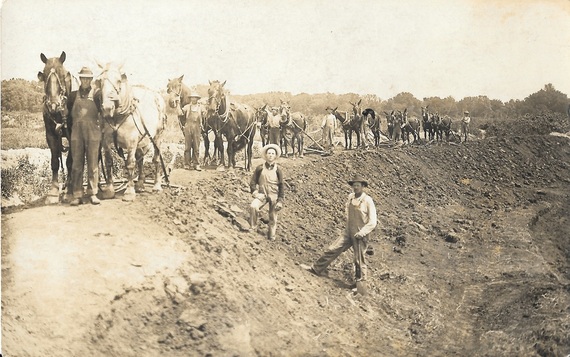 Photo 581, McCourtneys moving a rail bed. Charlie McCourtney is standing in the foreground, on the left.
Photo 581, McCourtneys moving a rail bed. Charlie McCourtney is standing in the foreground, on the left.
A post was made showing Bruce McCourtney building a realigned rail line. Don't how much you know about that, but I may know a little.
This is from my dad [J. C. Layden] and Lloyd Vrtiska.
There is a steep bank along the Nemaha and the rail line located around 3-1/2 miles north of Table Rock, right by "Uncle John's" Place. It washed over the tracks so often that they had to bore holes in the bank and insert long cables into the holes and then pump concrete into the holes. And it still occasionally washed onto the track.
Lloyd remembers Bruce building a new line there and the railroad building a new bridge . He is pretty sure this happened in 1930. He also said that Bruce dropped a number of used up steam engines new the bridge to provide ballast in the river.
Lloyd also said Bruce did a lot of work for the railroad so the picture may be of a different project.
Dad said that as management changed knowledge of this sore spot was lost so whenever a new superintendent took over he would tell them about the bad bank. They were glad to know and said they would watch it closely.
This is from my dad [J. C. Layden] and Lloyd Vrtiska.
There is a steep bank along the Nemaha and the rail line located around 3-1/2 miles north of Table Rock, right by "Uncle John's" Place. It washed over the tracks so often that they had to bore holes in the bank and insert long cables into the holes and then pump concrete into the holes. And it still occasionally washed onto the track.
Lloyd remembers Bruce building a new line there and the railroad building a new bridge . He is pretty sure this happened in 1930. He also said that Bruce dropped a number of used up steam engines new the bridge to provide ballast in the river.
Lloyd also said Bruce did a lot of work for the railroad so the picture may be of a different project.
Dad said that as management changed knowledge of this sore spot was lost so whenever a new superintendent took over he would tell them about the bad bank. They were glad to know and said they would watch it closely.
|
Postscript
Larry's comments got a couple of comments from Lloyd's son Jerry. Jerry Vrtiska: " If you are talking about the railroad bridge North of TR. There is still a couple of old Steam engine boilers in the water, east of the bridge." Larry: "Yes, I was talking about the railroad bridge north of TR. Did not know they were east of the bridge." Jerry: I think they moved to the East from where they were. A lot of water under the bridge moved it. |
north, south, east, west?
how the railroad moved the sun around
Sharla, I see you called the Atchison and Nebraska a north - south line. When I started working at the depot the trains were called Eastbound and Westbound.
I told dad they were wrong because I knew where the sun came up and it wasn't towards Elk Creek!
I was told there easy a right way and the railroad way and if I want my check signed I was to do it the railroad way.
Found out later the destination of the trains determined their directed. In this case the southbound train ended up in St. Louis which was east of Lincoln and the northbound ended up in Denver or Billings, , Montana which was west of Lincoln.
So that's how the railroad moved the sun around!
I told dad they were wrong because I knew where the sun came up and it wasn't towards Elk Creek!
I was told there easy a right way and the railroad way and if I want my check signed I was to do it the railroad way.
Found out later the destination of the trains determined their directed. In this case the southbound train ended up in St. Louis which was east of Lincoln and the northbound ended up in Denver or Billings, , Montana which was west of Lincoln.
So that's how the railroad moved the sun around!
train orders
|
Dear Sharla. More about train orders, which you posted on the train page. Here is something about Train Order No. 225.
|

The top train order was green and designated Form 19; it was a normal order used to direct movement of trains or to inform trains of sore spots in the track ahead.
In this case it was not addressed to a train but "OPR". This was to inform the operator of what was to happen at his station .
The order addressed to the trains were handed up prior to arrival at Table Rock.
In this case No. 68, an eastbound train (south at Table Rock ) may have got the order at Elk Creek. No 61 – westbound/north at Table Rock, may have received his order at Humboldt
Note the “Com” at the bottom of the order. This indicates the time the order was repeated back to the train dispatcher at Lincoln and if repeated correctly the dispatcher would say "complete 1009 am. If the went out or the OPR was somehow unable to repeat the order then it was to be acted on as if not sent. No action was authorized by the order because it had not been "made complete".
The bottom order is the one that carries a bigger story,
More later.
In this case it was not addressed to a train but "OPR". This was to inform the operator of what was to happen at his station .
The order addressed to the trains were handed up prior to arrival at Table Rock.
In this case No. 68, an eastbound train (south at Table Rock ) may have got the order at Elk Creek. No 61 – westbound/north at Table Rock, may have received his order at Humboldt
Note the “Com” at the bottom of the order. This indicates the time the order was repeated back to the train dispatcher at Lincoln and if repeated correctly the dispatcher would say "complete 1009 am. If the went out or the OPR was somehow unable to repeat the order then it was to be acted on as if not sent. No action was authorized by the order because it had not been "made complete".
The bottom order is the one that carries a bigger story,
More later.
snippets about the table rock cemetery
Larry's father, J. C. Layden, was the treasurer and secretary for the cemetery board from 1960 and until his death in 2001. Larry says that he gleaned this information gleaned from his dad's papers.
|
THE CIVIL WAR STATUE
The program for the unveiling of the "Soldiers Monument" took place on Saturday, December 5th, 1903 at 1:30 p.m. It was erected by the John N. Gere Post of the Grand Army of the Republic and by the Womens Relief Corps. ' Page 241 of the book "Monuments and Masterpieces" shows the statue's name as "The Lone Sentry" by John Quincy Adams Ward. The original one stands on the West Drive opposite Sixty Seventh Street in Central Park in New York City. Ward's monument was commissioned by the Seventh Regiment National Guard to commemorate the 58 men from the New York Regiment who died in the Civil War. A lone soldier of the Seventh Regiment on guard duty rests the button of his rifle on the ground. Ward's memorial was finished in 1869 but not unveiled until June 22, 1874. |
FORMAL ORGANIZATION OF THE CEMETERY
The citizens of Table Rock met at the M. E. Church on July 17, 1880 and authorized The Table Rock Cemetery Ass'n. The cemetery deed is dated Sept. 26, 1884. The land was given by the Norris, Holmes & Giddings family's for the consideration of $1.00.
In 1891, the Table Rock Nursery furnished and set out Cedar and Catalpa trees at $3.00 each.
The oldest tree in Table Rock is thought to be the Catalpa tree in the Northwest section of the cemetery. It is 124 years old as of 2015.
In 1894 lumber for the first fence was hauled from Brownville, Nebr.
The 40-acre farm west of the cemetery was purchased in 1945 for $3,000.
The citizens of Table Rock met at the M. E. Church on July 17, 1880 and authorized The Table Rock Cemetery Ass'n. The cemetery deed is dated Sept. 26, 1884. The land was given by the Norris, Holmes & Giddings family's for the consideration of $1.00.
In 1891, the Table Rock Nursery furnished and set out Cedar and Catalpa trees at $3.00 each.
The oldest tree in Table Rock is thought to be the Catalpa tree in the Northwest section of the cemetery. It is 124 years old as of 2015.
In 1894 lumber for the first fence was hauled from Brownville, Nebr.
The 40-acre farm west of the cemetery was purchased in 1945 for $3,000.
the course of the nemaha
Kim Vrtiska posted a nice map awhile back of Table Rock. I noticed the Nemaha river on the map and how it flowed East for awhile.
Here is what the Argus edition of July 11, 1940 says about the course of the Nemaha.
The Nemaha River once went straight from the bend where there is a little fall and turned a little northeast, but when the river came up it overflowed its banks and there was a swamp on each side of the river. On the north side, it overflowed so much it made a lake for toads, frogs, snakes and fur bearing animals.
The [railroad] pumping station was not over half a block away, and it was hard for the old man who pumped there, so the railroad cut the course of the river to flow straight east.
They built two rows of piling along the side of the river and filled it with dirt, and then built a cement dam. Part of it is still there.
I noticed white structures along the river bank on the map.
Here is what the Argus edition of July 11, 1940 says about the course of the Nemaha.
The Nemaha River once went straight from the bend where there is a little fall and turned a little northeast, but when the river came up it overflowed its banks and there was a swamp on each side of the river. On the north side, it overflowed so much it made a lake for toads, frogs, snakes and fur bearing animals.
The [railroad] pumping station was not over half a block away, and it was hard for the old man who pumped there, so the railroad cut the course of the river to flow straight east.
They built two rows of piling along the side of the river and filled it with dirt, and then built a cement dam. Part of it is still there.
I noticed white structures along the river bank on the map.
Engineer, i dub thee..."crash."
Seems like everyone on the railroad had a nickname.
To this day there are people whose first name I don't know.
There was: Sour Gut, Head On ( an engineer), Put Put, Gook, Level, Mike Mike, Double L (me) Corkey, Whitey, Blacky, Too Tall (5' 6"") and then Crash, whom I anointed. ‘
I told an engineer approaching the yard to come in real slow because I was not quite ready for him. He slowed down and a few minutes later the route cleared for him. I told him he could speed up now because he would get right in. I looked out the window and saw he was about to enter the yard, which had a 25 mph speed limit, and knew he had a heavy train.
To this day there are people whose first name I don't know.
There was: Sour Gut, Head On ( an engineer), Put Put, Gook, Level, Mike Mike, Double L (me) Corkey, Whitey, Blacky, Too Tall (5' 6"") and then Crash, whom I anointed. ‘
I told an engineer approaching the yard to come in real slow because I was not quite ready for him. He slowed down and a few minutes later the route cleared for him. I told him he could speed up now because he would get right in. I looked out the window and saw he was about to enter the yard, which had a 25 mph speed limit, and knew he had a heavy train.
 A "Y"
A "Y"
He said, “OK, Larry, what's the Yrated for?” Remembering the line from the movie "Dr. Strangelove" I told him a good engineer, I mean a really good engineer could....
At that time the road foreman of engines broke in and said, not pleasantly, that that Y was rated for 25 mph! And that had best be the speed of your train.
He then asked me for the name of the engineer I was talking to. I told him I didn't know his name, all I knew him by was his nickname. He asked me for his nickname and I told him we all called him CRASH. The radio went silent.
I don't now if he was too mad to speak or if he figured out that I was pulling his chain.
At that time the road foreman of engines broke in and said, not pleasantly, that that Y was rated for 25 mph! And that had best be the speed of your train.
He then asked me for the name of the engineer I was talking to. I told him I didn't know his name, all I knew him by was his nickname. He asked me for his nickname and I told him we all called him CRASH. The radio went silent.
I don't now if he was too mad to speak or if he figured out that I was pulling his chain.
hand signals
|
Here's a story told to me by my niece Joy Robison that happened while she was working as the agent/operator at Ravenna, Nebraska in the mid 70s.
Back before the switchmen had radios, they used hand signals to communicate with each other. They devised their own signals for track names. For instance, they might cross their arms to indicate that the next switch to throw should be for the X track. |
One day, Joy got a call from an irate woman telling her that while she was stopped at the crossing a railroad man made fun of her by making signs that indicated she was wacko or crazy and she didn't think it was a bit funny.
Joy asked what the railroad man did and the woman said he put his thumbs in his ears and moved his fingers around in a flapping manner.
Joy explained the hand signal system and told her the switch man was telling the other switch man to throw the switch for the stock track.The hands flapping around the ears was used to mimic the long ears of a cow.
The woman sort of believed her and hung up.
Joy asked what the railroad man did and the woman said he put his thumbs in his ears and moved his fingers around in a flapping manner.
Joy explained the hand signal system and told her the switch man was telling the other switch man to throw the switch for the stock track.The hands flapping around the ears was used to mimic the long ears of a cow.
The woman sort of believed her and hung up.
WHAT DO THE LIGHTS BELOW AN ENGINE'S HEADLIGHT MEAN?

Ever notice the lights below the headlight of an engine? There is one on each side of the engine. They may be huge, as on the derailed engine Sharla showed, or small as on the passenger engine sitting at Table Rock on the Wymore line.
These are called marker lights and an engine cannot occupy the main line unless they are working.
A train may occupy a main line if the timetable lists the train -- which makes it a scheduled train. Alternately, it can be authorized by train order, which makes it an Extra Train.
The markers can convey three types of information to an approaching train.
If they are not lit up it means it is a scheduled train and the meeting train can consult the timetable as to its number. If the color is green it indicates one or more trains are following,all using the same timetable authority , they are designated as First 67 or third 80. On and on.
The other color possible is white, indicating the train is an extra train, shown as Extra 5660 East.
An interesting side is that a scheduled train may only occupy the main line for 12 hours. It must be in the siding and clear of the main line when the 12 hours expire. Then it must wait for another train to overtake it and stop. In that event, the train on the main line would display green markers and the other train could follow using the first train authority. This wait could sometime be days long, The last train of a section would not display green markers. It's lights would be dark, indicating just a scheduled train.
'
Flags could be used instead of lights.
So now when you see pictures of steam engines with white flags on the front you will know know what they mean.
These are called marker lights and an engine cannot occupy the main line unless they are working.
A train may occupy a main line if the timetable lists the train -- which makes it a scheduled train. Alternately, it can be authorized by train order, which makes it an Extra Train.
The markers can convey three types of information to an approaching train.
If they are not lit up it means it is a scheduled train and the meeting train can consult the timetable as to its number. If the color is green it indicates one or more trains are following,all using the same timetable authority , they are designated as First 67 or third 80. On and on.
The other color possible is white, indicating the train is an extra train, shown as Extra 5660 East.
An interesting side is that a scheduled train may only occupy the main line for 12 hours. It must be in the siding and clear of the main line when the 12 hours expire. Then it must wait for another train to overtake it and stop. In that event, the train on the main line would display green markers and the other train could follow using the first train authority. This wait could sometime be days long, The last train of a section would not display green markers. It's lights would be dark, indicating just a scheduled train.
'
Flags could be used instead of lights.
So now when you see pictures of steam engines with white flags on the front you will know know what they mean.
j. c. layden, telegraph operator
|
One time the Telegraph line went down at Table Rock so Dad adjusted the relays and sender and he was able to send again.
Very few knew how to adjust like that. When the wire man found the break in the wire and spliced it he discovered that Dad had adjusted the current so well that he was transmitting through an open break in the wire and the current was being carried by the wet grass between each end of the wire. |
the coaling tower
How things worked
Sharia posted a picture of the cooling tower and said it looked like it was loading coal into a car below the tower.
Most likely it was already loaded with coal and was dumping into a pit below the car. Then men in the pit would shovel the coal into buckets on a conveyer chain running to the top and dump the coal into those large boxes located on the top of the tower. There was a conveyer on both sides on the tower, one leading to each box. Then the coal would flow through tubes into the big round bin of the tower. You can see them at the top on each side. These look like insect legs because the are folded up.
The tube in front of the tower is a stand pipe used for loading water into the water tender pulled behind the engine. The engine would pull up beside the Stan standpipe and then the brakeman standing atop the tender would reach over and pull the end of the stand pipe over and position it atop the tender, pull a rope to release the water and fill the tender. The picture posted of For stopping in Table Rock shows a stand pipe alongside the track. The fill up took time so some railroads devised a system used for there hot mail passenger trains enabling them to take on water without stopping.
They built a large scoop beneath the engine which when dropped would scoop up water from a swimming pool like tank between the tracks. The water would be forced back into the tender. And off they'd go!
Most likely it was already loaded with coal and was dumping into a pit below the car. Then men in the pit would shovel the coal into buckets on a conveyer chain running to the top and dump the coal into those large boxes located on the top of the tower. There was a conveyer on both sides on the tower, one leading to each box. Then the coal would flow through tubes into the big round bin of the tower. You can see them at the top on each side. These look like insect legs because the are folded up.
The tube in front of the tower is a stand pipe used for loading water into the water tender pulled behind the engine. The engine would pull up beside the Stan standpipe and then the brakeman standing atop the tender would reach over and pull the end of the stand pipe over and position it atop the tender, pull a rope to release the water and fill the tender. The picture posted of For stopping in Table Rock shows a stand pipe alongside the track. The fill up took time so some railroads devised a system used for there hot mail passenger trains enabling them to take on water without stopping.
They built a large scoop beneath the engine which when dropped would scoop up water from a swimming pool like tank between the tracks. The water would be forced back into the tender. And off they'd go!
wire failure
"clearing" a train in the face of a wire failure
The operator and dispatcher need to communicate to "clear" the train orders issued. How do they do that if communication between the train order operator and the train dispatcher fails?
The procedure or solution we followed when I worked was different than what was done in the early days, and it was seldom utilized when I worked.
When the dispatcher was through issuing train orders for an approaching train, he would tell the operator to "clear him up" . Then the operator would list on a Form A all the orders addressed to the train; the operator would then tell the dispatcher the orders he had listed. If the dispatcher agreed with the list, he would say "OK" and give the time.
If the telegraph/telephone line went dead, then the operator could on his own deliver the train orders and show on the clearance "Wire Failure" instead of a time stated by the dispatcher. This was safe because you never worked backwards with train orders. You could change the meeting locations but only to stations down the line. If the wire failed, the dispatcher had to assume the operator would deliver the orders he had issued.
This happened to me once. The telephone was dead and the dispatcher couldn't telegraph. When the train got close, I issued a "wire failure" clearance and kept the train moving. Later when the phone came back up the dispatcher told me to clear the train up. I told him I already had. He asked me how I did that and I told him I issued a "wire failure clearance. He said it was the first time he had heard of that being done. I told him it was in the book of rules. He said O.K. It was the topic of the day for awhile. I think they knew I was just showing off but they knew it was legal.
The procedure or solution we followed when I worked was different than what was done in the early days, and it was seldom utilized when I worked.
When the dispatcher was through issuing train orders for an approaching train, he would tell the operator to "clear him up" . Then the operator would list on a Form A all the orders addressed to the train; the operator would then tell the dispatcher the orders he had listed. If the dispatcher agreed with the list, he would say "OK" and give the time.
If the telegraph/telephone line went dead, then the operator could on his own deliver the train orders and show on the clearance "Wire Failure" instead of a time stated by the dispatcher. This was safe because you never worked backwards with train orders. You could change the meeting locations but only to stations down the line. If the wire failed, the dispatcher had to assume the operator would deliver the orders he had issued.
This happened to me once. The telephone was dead and the dispatcher couldn't telegraph. When the train got close, I issued a "wire failure" clearance and kept the train moving. Later when the phone came back up the dispatcher told me to clear the train up. I told him I already had. He asked me how I did that and I told him I issued a "wire failure clearance. He said it was the first time he had heard of that being done. I told him it was in the book of rules. He said O.K. It was the topic of the day for awhile. I think they knew I was just showing off but they knew it was legal.
how to find the break?
Back in the old days if the wire went out each operator would ground the wire at his station and try to communicate first in one direction and then the other. If Humboldt could send to Dawson and Table Rock send to Elk Creek but the two stations could nor send to each other they knew the wire was broken between Table Rock and Humboldt. In those days it might take the lineman days to get to the broken wire so the operator at Table Rock and Humboldt would have to grab a pair of pliers and a length of wire and start walking towards each other until the break was found and then splice the wire. Humboldt operator might be lucky and find the break a short distance from the depor. I don't know if the Table Rock operator had to walk the 8 miles to the splice. Maybe he could tell the wire was working by the sound. The Indians used to call the Telegraph the "Singing Wire". I remember a painting of an Indian on a horse leaning against a pole listening to the "singing wire".
the wheels on the train went
round and round
|
The drive wheels on train engines were not solid steel. They were encircled by a "tire" like those used around wooden wheels on wagons. Then when the wheels became worn or developed "flat" spots the outer tire could be replaced, not the whole wheel. Sometimes the time became loose or damaged. Then the train would have to sit and wait for a replacement engine.
|



